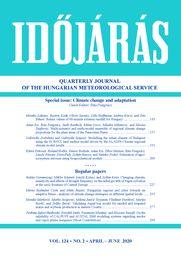IDŐJÁRÁS - angol nyelvű folyóirat
Vol. 124, No. 2 * Pages 143–309 * April - June 2020
 |
Special issue: Climate change and adaptation |
 letöltés [pdf: 3571 KB]
letöltés [pdf: 3571 KB]
Hungarian regions and cities towards an adaptive future – analysis of climate change strategies on different spatial levels
Mária Szalmáné Csete and Attila Buzási
DOI:10.28974/idojaras.2020.2.6 (p. 253–)
Mária Szalmáné Csete and Attila Buzási
DOI:10.28974/idojaras.2020.2.6 (p. 253–)
IDŐJÁRÁS folyóirat

Az IDŐJÁRÁS a HungaroMet Nonprofit Zrt. negyedévenként megjelenő angol nyelvű folyóirata
Megrendelhető a journal.idojaras@met.hu címen.
A szerzőknek szánt útmutató itt olvasható.
Megrendelhető a journal.idojaras@met.hu címen.
A szerzőknek szánt útmutató itt olvasható.









